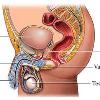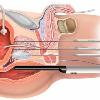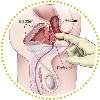

- » Finger length clue to risk of prostate cancer?
- » Now, remote sensing to kill prostate cancer
- » New vitamin E treatment for prostate cancer
- » 'Watchful waiting' often best strategy for low-risk prostate cancer
- » Prostate cancer risk increases with number of affected family members
- » Prostate cancer patients should not take dietary supplements
Topics: Health Tags: Prostate Cancer View |
Topics: Health Tags: Prostate Cancer View |
Topics: Health Tags: Prostate Cancer View |
|||||||||
Topics: Health Tags: Prostate Cancer View |
Topics: Health Tags: Prostate Cancer View |
Topics: Health Tags: Prostate Cancer View |
|||||||||
wmicrograph Tags: Prostate Cancer View |
Topics: Health Tags: Prostate Cancer View |
Topics: Health Tags: Prostate Cancer View |
|||||||||
prostate cancer. Needle biopsy. HPS stain. ICDO = OMIM = 176807 DiseasesDB = 10780 MedlinePlus = 000380 eMedicineSubj = radio eMedicineTopic = 574 MeshID = D011471
Prostate cancer is a form of cancer that develops in the prostate, a gland in the male reproductive system. Most prostate cancers are slow growing; however, there are cases of aggressive prostate cancers. The cancer cells may metastasize (Metastasis) (spread) from the prostate to other parts of the body, particularly the bones and lymph nodes. Prostate cancer may cause pain, difficulty in urinating (urination), problems during sexual intercourse, or erectile dysfunction. Other symptoms can potentially develop during later stages of the disease.
Rates of detection of prostate cancers vary widely across the world, with South and East Asia detecting less frequently than in Europe, and especially the United States. Prostate cancer tends to develop in men over the age of fifty and although it is one of the most prevalent types of cancer in men, many never have symptoms, undergo no therapy, and eventually die of other causes. This is because cancer of the prostate is, in most cases, slow-growing, symptom-free, and since men with the condition are older they often die of causes unrelated to the prostate cancer, such as heart/circulatory disease, pneumonia, other unconnected cancers, or old age. About 2/3 of cases are slow growing "pussycats", the other third more aggressive, fast developing being known informally as "tigers".
Many factors, including genetics and diet (Diet (nutrition)), have been implicated in the development of prostate cancer. The presence of prostate cancer may be indicated by symptoms, physical examination, prostate specific antigen (PSA), or biopsy. There is controversy about the accuracy of the PSA test and the value of screening. Suspected prostate cancer is typically confirmed by taking a biopsy of the prostate and examining it under a microscope. Further tests, such as CT scans and bone scans, may be performed to determine whether prostate cancer has spread.
Treatment options for prostate cancer with intent to cure are primarily surgery, radiation therapy, and proton therapy. Other treatments, such as hormonal therapy (Hormonal therapy (oncology)), chemotherapy, cryosurgery, and high intensity focused ultrasound (HIFU) also exist, depending on the clinical scenario and desired outcome.
The age and underlying health of the man, the extent of metastasis, appearance under the microscope, and response of the cancer to initial treatment are important in determining the outcome (prognosis) of the disease. The decision whether or not to treat localized prostate cancer (a tumor that is contained within the prostate) with curative intent is a patient trade-off between the expected beneficial and harmful effects in terms of patient survival and quality of life.
Icd10: ICD10C61c60
Icd9: ICD9185









